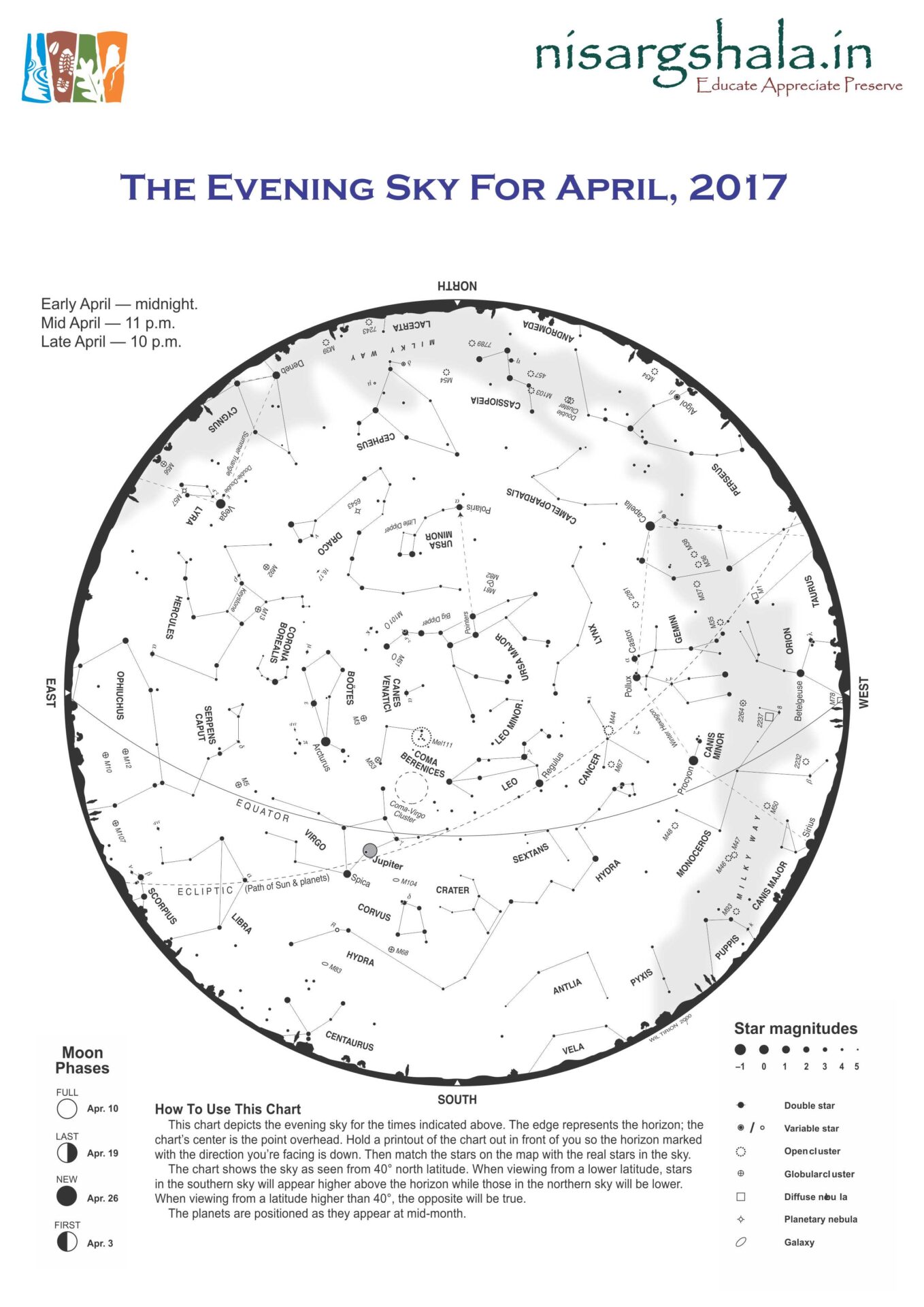Lie back and look up
Does this constellation come here every weekend?
Such questions show the life, we human beings are living. The life which is restricted only to weekends. We have fun, we party, we meet friends and families, we watch movies on weekends. It was quite obvious that kids of these times, feel that the stars also shine only weekends. Its we, the adults, the entire society as whole, failed to give exposure to our kids to nature and the dark space up and above.
So the answer is….write / contribute , about what you think is the correct answer, in comment/reply section.
April 2017, yet another month full of celestial thrills and amazing events. You have got plenty of occasions this month to lie on your back and look up in the sky.
LEO’S HEART MEETS MOON—APRIL 6

On April 6, the moon will be seen in close proximity to the heart of Leo the lion.
The waxing gibbous moon passes very close to the brightest stellar member of the constellation: Leo, the lion. You will find the brilliant blue-white star Regulus only a degree away from the moon.
Using your thumb to hide the moon’s disc and block its associated glare, see if you can spot the distinctive backwards question-mark-shaped pattern of stars that mark the head of the cosmic cat.
JUPITER AT ITS BEST—APRIL 7
Look for Jupiter to be at its best and brightest of the entire year.
The largest planet in the solar system officially reaches opposition—meaning it is on the opposite side of the sky from the sun—and will appear to be the largest disc in the sky, visible from sundown to sunrise. For Jupiter, opposition also means that this is the closest the planet will come to Earth, at 414 million miles. This will make it stunningly bright, outshining even than the nearby brilliant star Spica.
Make sure to check out its retinue of moons through binoculars, as well as Jupiter’s own complex atmospheric details through a small telescope. For those with larger backyard telescopes, watch for the famed Great Red Spot to pop into view as the planet spins on its axis. This cyclonic storm is twice the size of Earth and has been raging for at least three centuries.
MOON JOINS JUPITER—APRIL 10

A few days after the date of its opposition, Jupiter continues to dominate the sky, and tonight it is joined by a full moon.
MOON SLIDES PAST SATURN—APRIL 16

Early on April 16, Saturn will come into sharp relief near the moon.
If you have never seen the planet Saturn, this morning the moon will conveniently act as a guidepost to help skywatchers see the ringed wonder. Early-bird viewers can catch this celestial pair high in the southern sky in the pre-dawn hours. By dawn, they will be setting in the southwest and lost in the quickly-brightening morning sky.
Even the smallest telescope trained on Saturn will reveal the famous set of rings that encircle the gas giant and even a few of its brightest and largest moons like Titan and Rhea.
MARS POSES WITH PLEIADES—APRIL 21

As Mars fades, it will still be slightly visible, and will brush past the Seven Sisters on April 21.
The Red Planet is slowly getting overwhelmed by the glow of evening twilight as it sinks closer to the western horizon, but tonight it glides past the well-known star cluster Pleiades.
The 360-light-year-distant stellar grouping, also known as the Seven Sisters, will appear only 3 degrees away from the planet in the sky.
LYRID METEOR SHOWER PEAKS—APRIL 22

Meteors can be seen near Lyra on April 22.
Stay up late on April 21, and look for a flurry of shooting stars streaming from the northeast sky near the constellation Lyra. The Lyrid meteor shower should peak starting after 11 p.m. local time, but promises to really kick in after midnight, when the moon will have set and left behind dark skies.
Until the pre-dawn hours on the morning of April 22, as many as 15 to 20 meteors per hour should be visible across the Northern Hemisphere in areas away from light-polluted cities.
VENUS ALONGSIDE THE MOON—APRIL 23

Venus can be seen alongside the moon on April 23.
A great observing challenge awaits the early morning skywatcher as Venus pairs up with the crescent moon. Using binoculars to cut through the glow of morning twilight, look very low towards the eastern horizon about 45 minutes before sunrise for both the planet and moon.
ALDEBARAN MEETS THE MOON—APRIL 28

Orange Aldebaran and the Moon appear again, this time together, on April 28.
For the second time this month, the moon returns to the Taurus constellation and its brightest star, Aldebaran. The two objects will have an even closer encounter, appearing only a half degree from each other–about equal to the width of the full moon.
However, lucky skywatchers across Europe, North Africa, and North America will get a chance to see the star slip behind the moon in what is called a lunar occultation. For specific occultation times for cities around the world, check out this time table from the International Occultation Timing Association.
Happy star gazing to you.
Imagery courtesy – NGC
Share this if you like it..






8 Responses
Hello there I am so grateful I found your weblog, I really found you by accident, while I was searching on Digg for something else, Anyways I am here now and would just like to say many thanks for a fantastic post and a all round enjoyable blog (I also love the theme/design), I don’t have time to read through it all at the minute but I have book-marked it and also included your RSS feeds, so when I have time I will be back to read a great deal more, Please do keep up the excellent b.|
Appreciate this post. Will try it out.
Very informative post. Keep up great job. Would love to do camp with you guys, along with my kids, once m back to India.
Thanks Raghu for appreciation. However to see the clearest of the night sky, April and May are the best months, make sure you make it in time.
Nice to become browsing your weblog once more, it continues to be months for me. Nicely this article that ive been waited for so long. I require this article to total my assignment in the school, and it has exact same topic together with your post. Thanks, great share.
Attractive section of content. I just stumbled upon your blog and in accession capital to assert that I acquire actually enjoyed account your blog posts. Any way I will be subscribing to your augment and even I achievement you access consistently quickly.
Wonderful job right here. I seriously enjoyed what you had to say. Keep going because you undoubtedly bring a new voice to this subject. Not many people would say what youve said and still make it interesting. Properly, at least Im interested. Cant wait to see far more of this from you.
Your way of telling everything in this piece of writing is in fact
good, all be able to simply understand it, Thanks a lot.